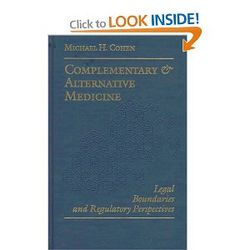Complementary and Alternative Medicine: Legal Boundaries and Regulatory Perspectives
- Author: Michael H. Cohen
- Published: January 1998
- Publisher: Johns Hopkins University Press
- Number of pages: 200 pages
- To Order: [1]
Product Description
A third of all Americans use complementary and alternative medicine - including chiropractic, acupuncture, homoeopathy, naturopathy, nutritional and herbal treatments and massage therapy - even when their insurance does not cover it and they have to pay for such treatments themselves. Nearly a third of US medical schools offer courses on complementary and alternative therapies. Congress has created an Office of Alternative Medicine within the National Institutes of Health, and federal and state lawmakers have introduced legislation authorizing widespread use of such therapies. The author of this study contends that these institutional and legislative developments express a paradigm shift to a broader, more inclusive vision of healthcare than conventional medicine admits. Cohen explores the legal issues which healthcare providers (both conventional and alternative), institutions and regulators confront as they contemplate integrating complementary and alternative medicine into mainstream US healthcare. Challenging traditional ways of thinking about health disease and the role of the law in regulating health, he begins by defining complementary and alternative medicine and then places the regulation of orthodox and alternative healthcare in historical context. He next examines the legal ramifications of complementary and alternative medicine, including state medical licensing laws, legislative limitations on authorized practice, malpractice liability, food and drug laws, professional disciplinary issues and third-pary reimbursement. The final chapter offers a framework for thinking about the possible evolution of the regulatory structure, suggesting how it might develop to support a comprehensive, holistic and balanced approach to health, that permits integration of orthodox medicine with complementary and alternative medicine, while continuing to protect patients from fraudulent and dangerous treatments.
Book Info
Chapman Univ., Orange, CA. Analysis of the present legal status of complementary and alternative medicine. For clinicians, legal professionals, patients, and institutional health care providers and insurers Hardcover; also available in softcover.
About the Author
Michael H. Cohen is associate professor of law at Chapman University School of Law in Orange, California.
